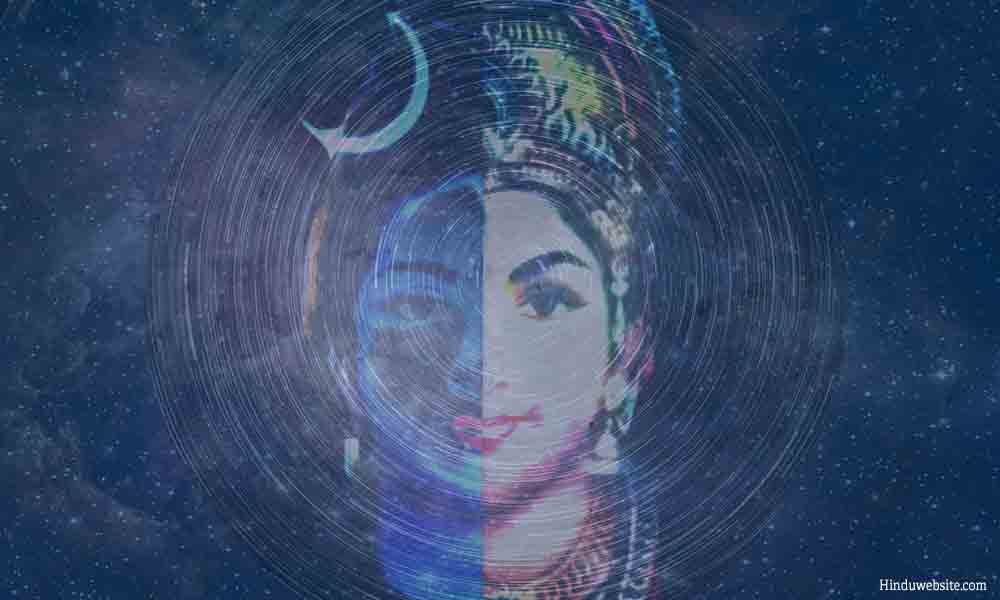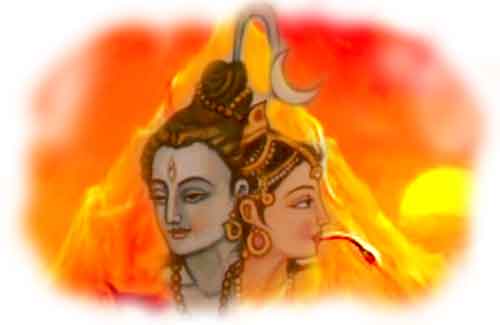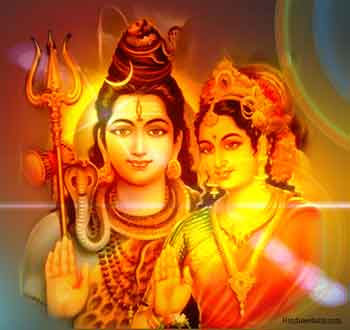
Is God in Hinduism Male or Female?

Summary: This essay is about the essential nature and gender identity of God or the Supreme Being in Hinduism.
The concept of God in Hinduism is complicated because for every conclusion you draw about the nature of God, you will find an exactly opposite one. By God we mean the highest, supreme Being. When we envision that Being, we typically envision a male God with a form because we are accustomed to worship images. Most people do worship a male God in Hinduism. Yet, the popular practice or belief does not settle the issue. It is just one of the several examples of the complex and diverse nature of Hinduism and the variance between theory and practice which often leads to misunderstanding and incongruity about the faith.
The reality is that the gender of God is indeterminate because God is the sum of all. The reality of God contains in itself all the realities, potencies and possibilities. Secondly, although in Hinduism we take for granted the existence of God, even that conclusion is not final. The mystery or incomprehensibility of God is such that nothing can be said about him (or her) with certainty. In Hinduism there are two fundamental beliefs about God. One school thinks that God is (astika) and the other believes that God is not (nastika). The truth is perhaps somewhere in between. God can neither be existent nor nonexistent. It must be both at the same time. It can be neither pure consciousness only nor pure energy only. It must be both and even more. It can neither be male nor female. Hence, the Hindu texts refers to that composite reality with the neutral expression, "That (tat)," or it.
As a mental concept, That is the sum of your beliefs and worldviews. That is both known and unknown. That fits into any form, shape or concept you envision. That neither opposes you nor asserts itself, for That is everything, which means it is also you. Therefore, it becomes whatever you want it to be. If you think it is nonexistent, it will become nonexistent for you to perpetuate your delusion and let you live with your belief or disbelief.
It is why the subject of God’s existence or nonexistence cannot easily be resolved. To know it one has to go beyond the mind and senses and witness the truth within oneself in a subjective state. Common people cannot truly comprehend the truth of God because their perceptions are colored by the impurities of egoism, delusion and attachments. We perceive truths according to or desires and expectations, a fact which even science acknowledges.
For all practical purposes, whatever we think or conjure up in our minds about God is but an approximation, formation or creation rather than the reality. It is an objective truth, limited to our knowledge, ideation and perceptions. Therefore, until we cultivate clear thinking and pure discernment, the truth of God will elude us. Our scriptures affirm that God is all and in all. It means that denying God is denying oneself. This is one of the paradoxes, which the human mind cannot easily reconcile.
The Vedas proclaim Brahman as the highest supreme reality, who is universal, formless, infinite, eternal, indestructible, incomprehensible, indescribable, beyond the mind and senses, the most ancient, first, without a second, and so on. It is also the creator, preserver and destroyer, who pervades all creation and envelops it. The Upanishads declare That to be the source and support of all. All are its manifestations. All the gods and goddesses are said to be Brahman only in their highest aspect. The same Brahman is also the Self (atman) of all.
Now, these conclusions about God in Hinduism are not final. The Nastika (is not) schools do not acknowledge any God or supreme being. In the West, skepticism about the existence of God gained support in the last few centuries in the aftermath of industrial revolution. There was a time when a mere allusion to the lack of faith or disbelief in God would have been deemed heresy or blasphemous and attracted capital punishment or life imprisonment.
The same was not the case in India where skepticism and disbelief in God existed for a long time. From the earliest times the country was free from the shackles of autocratic theocracies and rigid philosophies. The kings were tolerant and encouraged debates and discussions among rival groups to prove their views. The result was a great churning of diverse ideas and philosophical schools, long before the birth of the Buddha and Mahavira.
The free flow of thought led to the development of complex philosophies and religious systems. As a result, by sixth century BC the Indian subcontinent witnessed an upsurge of religious sects, teacher traditions, philosophies and ascetic movements, which are now an explicit or implicit part of present-day Hinduism, Buddhism or Jainism. We may broadly classify these developments into three main categories, which are stated below.
1. The theistic (astika) schools. They acknowledge God or a universal Being as the source of creation and aimed to attain liberation through ritual worship and spiritual practices. Leading balanced lives and pursuing both material and spiritual aims, they strive to fulfill their obligation to God and to the practice of Dharma. They propitiate gods and God through prayers and invocations and uphold Dharma as their obligatory duty, often subjecting themselves to rigorous, physical and spiritual transformation to attain liberation.
2. The nontheistic (nastika) schools. They hold the opposite view, limiting their observation and inquiry to the perceptual reality and ignoring all metaphysical notions, including the existence of God and afterlife, which could not empirically be ascertained. For them, the objective reality is created by a series of preexisting causes and effects, whose origins cannot be fathomed with the mind or senses. Hence, they believe that best way to improve our lives is by observing it and learning from it.
3. The skeptics. They fall into the middle category, who are not sure but keep an open mind, knowing that existence is indeterminate. They think that it is difficult to speculate upon metaphysical truths to arrive at definitive conclusions about God. Some even think it is futile to speculate since it serves no practical purpose to experience happiness or reduce our suffering. Hence, they suspend all speculative inquiry into God and rely upon their own wisdom or the teachings of their teachers or schools to improve their lives through self-effort.
Gender identity of the Creator God
Thus, one can see that in Hinduism the existence of God is not fully settled, although a majority of Hindus worship a male God with firm faith as the lord of all. So is the case with God’s gender. The Supreme Reality of Brahman in its manifested aspect as the lord and creator of all has two fundamental aspects. They are known as Purusha and Prakriti. They represent the masculine and feminine aspects of creation. Purusha is pure consciousness or Self, and Prakriti represents the materiality or body of Purusha. You may also call them by other names such as Shiva and Shakti or Father God and Mother Goddess.
Their union represents the whole creation, which is personified in the scriptures as Isvara, Saguna Brahman or manifested Brahman. Considering this model, we can discern following three streams of thought regarding the gender identity of creator God.
1. Purusha is the creator. Prakriti is his dynamic projection and unreal. As the supreme Being (Isvara), he is the controller and creator of all. Shakti or Prakriti is his dependent, creative force, who executes his will to manifest worlds. This view is predominant in Nondualistic Vedanta schools.
2. Para Shakti is the creator. Prakriti is her dynamic aspect. As the Mother Goddess, she is the supreme Being, who executes her own will. Purusha is a passive witness, who remains in the background and silently enjoys the play of Shakti. This view is prevalent in many schools of Tantra.
3. Both Purusha and Prakriti act as co-creators. Both are real, eternal, interdependent and indestructible, but perform all functions together. It is difficult to separate them, although in the lower planes of existence they may appear as separate and distinct due to the power of Maya.
The all-inclusive supreme reality
The human mind cannot fathom metaphysical truths. In the universal scheme of things, considering all the possibilities and our notions of what constitutes perfection or completeness, we may safely assume that God or the Supreme Being can neither be male nor female. That entity, whom we call God for our convenience, must be a composite being who represents within itself all the dualities and opposites.
In the beingness of that reality, everything must exist in all possible ideations, potencies, conditions, states and formations. Its beingness must be the sum of all beings and all perceptible, imperceptible, possible and impossible phenomena. Such a Being who represents within itself all realities and polarities in all their possible permutations and combinations cannot be this or that. It must be everything and everywhere, without a second.
The Vedas acknowledge this eternal and absolute truth of that Supreme Being, known as Brahman, the absolute, perfect and complete (sampurna) Truth or Reality, which does not change with our perception, knowledge or understanding, but remain eternally the same. This Brahman has no gender, no identifiable, specific form, name or function. The completeness of that absolute reality is such that even if something is taken out of it, it still remains complete. Nothing can diminish it or disturb it.
In the Vedas, it is referred to as the Being and Nonbeing, Known and Unknown and as Manifested and Unmanifested to represent its completeness. Gender or sex is an aspect of the material body, not of the soul. The Manifested Being, whom we call God or Isvara, whose body is said to be the whole material universe, must be both male and female and may also represent all the conditions in between.
For our convenience we may call that deity god or goddess, male or female, or worship it by whatever name or form we may imagine. Even if they are born out of our imagination, those names and forms would still be true because all possibilities exist in it, and nothing can be ruled out. Gender or sex in the material plane is a duality, and just as any other duality it is an illusion, not an absolute reality. Our aims should be to rise above all such dualities in spiritual practice to cultivate sameness.
 Purusha and Prakriti
Purusha and Prakriti
The Upanishads understand this supreme truth. Hence, they use the neutral word, “That” to represent that reality which contains in itself all dualities and polarities without being changed by them. That Being, who is called Brahman and Lord of all, has both manifested and unmanifested, and known and unknown aspects. It is neither male nor female nor both. It is visible and invisible, male and female, here and there, transcendental and immanent, inside and outside, with form and without form, and everything and nothing. It is what you want to be and what you make out of it, because it does not impose itself upon you, but lets you be.
These ideas form the foundation of Hindu theistic thought and its Upanishadic wisdom. They are at the core of its ritual and spiritual practices and essential beliefs. The consensus among its many sects and schools and which is also at the heart of present-day popular Hinduism is that the reality of Brahman translates into every object and phenomenon in creation. Shakti or the Universal Female is the body or the materiality of the universe, and Shiva or Universal Male is its soul or pure consciousness. One can see the same configuration in a living being also.
Such a Deity, who represents the eternal union of cosmic polarities and contains within itself all the realities (tattvas) and dualities, performs five main functions in the whole existence. They are, creation, preservation, concealment, revelation and destruction. These functions pertain to the names and forms of that deity, not to its essence. They can also be perceived in the functioning of Nature and our own bodies.
As the creator, it manifests all the worlds and beings. As the preserver, it supports and upholds all beings, objects, worlds and other created phenomena. As the concealer, it remains hidden, creating the illusion that the supreme reality is nonexistent and the physical reality is the only reality. As the revealer, it opens our eyes to the truths of existence and facilitates our liberation. As the destroyer, it withdraws everything at the end of creation and goes into temporary rest or sleep.
The composite nature of God is well illustrated in the divine manifestations of Shiva and Shakti as Ardhanariswara, the deity who is half male and half female. The left side of the deity is represented by Shiva and the right side by Parvathi. The deity symbolizes the eternal union and equality of Shiva and Parvathi. None can separate them, and none can worship one without worshipping the other. In other words, there are no secrets between them. They cannot be Discriminated against each other, nor can we discriminate between the devotees of Shiva from those of Parvathi.
 Shiva and Parvathi are inseparable. Together they represent the
Ardhanariswara aspect in creation
Shiva and Parvathi are inseparable. Together they represent the
Ardhanariswara aspect in creation
Conclusion
From the above, it can be seen that Hinduism is a complex faith. You cannot easily generalize anything, be it the nature, the gender or the composition of God. While it may create a lot of confusion in the minds of its practitioners, on the positive side it also offers a wide choice to them. As a Hindu, you can choose your deity and worship him or her in whatever way you deem fit. You may practice rituals. You may engage in spirituality, or you may engage in both. You may also do nothing, and let your life, or your karma, take its own course.
You will not find such freedom and leniency in other faiths, except perhaps in some schools of Buddhism, However, with regard to the worship of Mother Goddess, Hinduism stands alone. It is the only religion in today’s world where a female deity is recognized and worshipped as the Supreme being, superior to even the highest gods of Hinduism such as Brahma, Vishnu and Shiva. In some ritual traditions and schools of Hinduism, all the offerings are made to the Goddess only.
Suggestions for Further Reading
- What is the Color of God?
- What is Your Notion of God?
- God and You in Hinduism
- Who is the Dwarf in the Cosmic Dance of Shiva?
- Aspects, Emanations, Incarnations and Forms of God Vishnu
- Brahman According to Advaita and Dvaita in Hinduism
- Creation in Hinduism As a Transformative Evolutionary process
- Dvaita or Advaita What is the Truth?
- Four Types of Intelligence
- God and Creation in Hinduism
- The Vedic Symbolism of Gods and Demons
- Lessons from the Dance of Kali, the Mother Nature
- Life’s Lessons from Mother Nature
- The Duality of Shakti, the Two Faces of Creation
- The Mathematical Basis of Life As a Play of Numbers and Equations
- The True Meaning of Prakriti in Hinduism
- Gender Differences in Hinduism
- Traditional Status of Women in Hinduism
- About Goddess Parvathi or Shakti
- Hinduism - The Role of Shakti in Creation
- Hindu God Lord Shiva (Siva) - the Destroyer
- Essays On Dharma
- Esoteric Mystic Hinduism
- Introduction to Hinduism
- Hindu Way of Life
- Essays On Karma
- Hindu Rites and Rituals
- The Origin of The Sanskrit Language
- Symbolism in Hinduism
- Essays on The Upanishads
- Concepts of Hinduism
- Essays on Atman
- Hindu Festivals
- Spiritual Practice
- Right Living
- Yoga of Sorrow
- Happiness
- Mental Health
- Concepts of Buddhism
- General Essays
Notes
1. Traditionally, sex and gender are used synonymously to distinguish men from women or the males from females. However, in recent times their meaning has become distinct. Sex now refers to the biological aspect of the human body and gender is used mostly to refer to the roles which one plays in society or in daily life. This has created an interesting dynamic since the gender roles and dualities of both men and women have changed considerably in recent times.